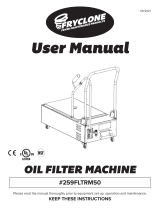
TO THE PURCHASER, OWNER AND STORE MANAGER
Please review these warning prior to posting them in a prominent location for reference
II L20-406 Rev 5 (3/14)
WARNING
DO NOT store or use gasoline or other flammable
vapors and liquids in the vicinity of this or any other
appliance.
WARNING
Improper installation, alteration, service or maintenance
can cause property damage, injury or death. Read the
installation, operating and maintenance instructions
thoroughly before installing or servicing this appliance.
WARNING
Installation, maintenance and repairs should be
performed by a Pitco Authorized Service and Parts
(ASAP) company technician or other qualified
personnel. Installation, maintenance or repairs by an
unauthorized and unqualified personnel will void the
warranty.
WARNING
Installation and all connections must be made according
to national and local regulations and codes in force.
WARNING
A country approved all pole circuit breaker with a
minimum open contact gap of 3mm must be used for
proper installation. (CE countries)
WARNING
During the warranty period if a customer elects to use a
non-original part or modifies an original part purchased
from Pitco and/or its Authorized Service and Parts
(ASAP) companies, this warranty will be void. In
addition, Pitco and its affiliates will not be liable for any
claims, damages or expenses incurred by the customer
which arises directly or indirectly, in whole or in part, due
to the installation of any modified part and/or received
from an unauthorized service center.
WARNING
This appliance, when installed, must be electrically
grounded in accordance with local codes, or in the
absence of local codes, with the National Electrical
Code, ANSI/NFPA 70, or the Canadian Electrical Code,
CSA C22.2, as applicable.
WARNING
Adequate means must be provided to LIMIT the
movement or this appliance without depending on the
electrical cord connection. Single appliances equipped
with legs must be stabilized by installing anchor straps.
All appliances equipped with casters must be stabilized
by installing restraining chains.
WARNING
DO NOT alter or remove structural material on the
appliance to accommodate placement under a
ventilation hood.
WARNING
This appliance is intended for commercial/professional
use only and should be operated by fully trained and
qualified personnel. It is not intended for continuous
mass production of food.
WARNING
This appliance is intended for indoor use only.
WARNING
If the power suppy cord is damaged, it must be replaced
by a Pitco Authorized Service and Parts (ASAP)
company technician, or a similarly qualified person in
order to avoid a hazard. In Europe, supply cords must
be oil resistant, sheathed flexible cable not lighter than
ordinary polychloroprene or other equivalent synthetic
elastomer-sheathed cord (Code designation 60245 IEC
57).
WARNING
The power supply must be disconnected before
servicing, maintaining or cleaning this appliance.
WARNING
The appliance is NOT water jet stream approved. DO
NOT clean the appliance with a water jet or steam
cleaner.
WARNING
DO NOT attempt to move this appliance or transfer hot
liquids from one container to another when the unit is at
operating temperature or filled with hot liquids. Serious
personal injury could result if skin comes in contact with
the hot surfaces or liquids.
WARNING
DO NOT sit or stand on this appliance. The appliance’s
front panel, tank, splash back, tank cover, work shelf,
drain board is not a step. Serious injury could result
from slipping, falling or contact with hot liquids.
WARNING
NEVER use the appliance as a step for cleaning or
accessing the ventilation hood. Serious injury could
result from slips, trips or from contacting hot liquids.
WARNING
Potential fire danger exists if the cooking oil level is
below the minimum indicated level. The cooking oil level
should NOT be allowed to fall below the minimum
indicated level line at any time. The use of old cooking
oil can be dangerous as it will have a reduced flash point
and be more prone to foaming over.
WARNING
The contents of the crumb catch and/or filter pan of any
filter system must be emptied into a fireproof container
at the end of each day. Some food particles can
spontaneously combust if left soaking in certain types of
oil or shortening.
WARNING
Completely shut the appliance down when
shortening/oil is being drained from the appliance. This
will prevent the appliance from heating up during the
draining and filling process. Serious injury can occur.
WARNING
DO NOT operate appliance unless all panels and
access covers are attached correctly.
WARNING
It is recommended that this appliance be inspected by a
qualified service technician for proper performance and
operation on a yearly basis.






















